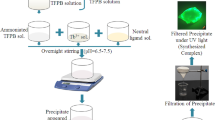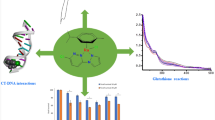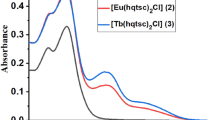Abstract
New indium(III) and gallium(III) meso-tetra(benzo-15-crown-5) porphyrinates are synthesized. The structure of complexes is determined from spectroscopy data. A comparative analysis of the luminescent properties of new compounds at temperatures of 298 and 77 K is performed. The indium(III) and gallium(III) crown-porphyrinates are established to exhibit fluorescent behavior at a temperature of 298 K, while phosphorescence radiation is totally absent at this temperature for both complexes. At the nitrogen boiling point (77 K), the two complexes give off both fluorescent and phosphorescent radiation. The prepared compounds can be interesting as luminescent temperature sensors operating on the basis on the intensity ratio between fluorescence and phosphorescence transitions in the temperature range of 77–203 K. The energies of triplet levels in indium(III) and gallium(III) crown-porphyrinate molecules suggest that the new compounds are capable of producing singlet molecular oxygen. Evidently, the new compounds can also be of interest as photosensitizers in photodynamic therapy of tumors.




Similar content being viewed by others
REFERENCES
Tsivadze, A.Yu., Usp. Khim., 2004, vol. 73, no. 1, p. 6.
Thanabal, V. and Krishnan, V., Inorg. Chem., 1982, vol. 21, p. 3606.
D’Souza, F., Chitta, R., Gadde, S., and Zandler, M., J. Phys. Chem. A, 2006, vol. 110, p. 4338.
Thanabal, V. and Krishnan, V., J. Am. Chem. Soc., 1982, vol. 104, p. 3643.
Tsivadze, A.Yu., Chernyad’ev, A.Yu., and Vannikov, A.V., RF Patent 2469440, 2012.
Chernyad’ev, A.Yu., Kotenev, V.A., and Tsivadze, A.Yu., Prot. Met. Phys. Chem. Surf., 2015, vol. 51, no. 6, p. 964.
Chernyad’ev, A.Yu., Kotenev, V.A., and Tsivadze, A.Yu., Prot. Met. Phys. Chem. Surf., 2019, vol. 55, no. 6, p. 1113.
Chernyad’ev, A.Yu. and Tsivadze, A.Yu., Prot. Met. Phys. Chem. Surf., 2018, vol. 54, no. 6, p. 1087.
Stuzhina, O.V., Lomova, T.N., Pelipets, O.V., and Girichev, G.V., Russ. J. Phys. Chem. A, 2008, vol. 82, no. 2, p. 154.
Bhatti, M. and Bhatti, W., Inorg. Nucl. Chem. Lett., 1972, vol. 8, p. 133.
Kadish, K.M. and Cornillon, J.L., Inorg. Chem., 1987, vol. 26, p. 4167.
Askarov, K.A., Berezin, B.D., Evstigneeva, R.P., et al., Porfiriny: struktura, svoistva, sintez (Porphyrins: Structure, Properties, Synthesis), Moscow: Nauka, 1985.
Solov’ev, K.N. and Borisevich, E.A., Usp. Fiz. Nauk, 2005, vol. 175, no. 3, p. 247.
El'yashevich, M.A., Atomnaya i molekulyarnaya spektroskopiya (Atomic and Molecular Spectroscopy), Moscow: Fizmatgiz, 1962.
Ermolaev, V.L. and Sveshnikova, E.B., Acta Phys. Pol., 1968, vol. 34, p. 771.
Lakowicz, J.R., Principles of Fluorescence Spectroscopy, New York, London: Plenum Press, 1983.
Chernyadyev, A.Yu., Logacheva, N.M., and Tsivadze, A.Yu., Russ. J. Inorg. Chem., 2005, vol. 50, no. 4, p. 552.
Krasnovsky, A.A., J. Photochem. Photobiol., A, 2018, vol. 354, p. 11.
Harriman, A., J. Chem. Soc., Faraday Trans. 2, 1981, vol. 77, p. 1281.
Gordon, A.J. and Ford, R.A., The Chemist’s Companion: A Handbook of Practical Data, Techniques, and References, New York: John Wiley and Sons, 1972.
Funding
The work was supported within the framework of the state order “Physical Chemistry of Functional Materials Based on Architectural Ensembles of Metal Oxide Nanostructures, Multilayer Nanoparticles, and Film Nanocomposites” (NIOKTR registration no. АААА-А19-119031490082-6) and the project “New Nanoscale Luminescent Temperature Sensors Based on Metal Porphyrins” under basic research program no. 14 of the Presidium of Russian Academy of Sciences “Relevant Problems of the Physical Chemistry of Surfaces and Design of New Composite Materials.”
Analytical measurements were carried out using the facilities of the Physical Methods of Investigation Center for Collective Use, Frumkin Institute of Physical Chemistry and Electrochemistry, Russian Academy of Sciences.
Author information
Authors and Affiliations
Corresponding author
Additional information
Translated by A. Kukharuk
Appendices
EXPERIMENTAL
Mass spectra were registered on an Ultraflex MALDI TOF instrument (Bruker Daltonics) without using a matrix. Electronic absorption and diffuse reflectance spectra were measured on a Lambda 35 instrument (Perkin Elmer). Luminescence spectra and the luminescence quantum yield (an absolute method) were measured on Fluorolog-3 modular fluorimeter (Horiba Jobin Yvon S.A.S.) equipped with a Quanta-φ integrating sphere. The quantum yield was calculated with the FluoroEssence® software. Quantum yield measurements were performed using a cuvette with four transparent faces and with a path length of 1 cm in the presence of atmospheric oxygen (i.e., no degassing of solutions). In order to avoid the inner filter effect [16], solutions of considered compounds were prepared in such a way that the absorbance of the most intensive Q band was ~0.005. Singlet oxygen luminescence spectra were registered using an InGaAs detector that was available with the Fluorolog-3 modular spectrofluorometer. Gallium(III) chloride, indium(III) chloride, and polystyrene were purchased from Sigma-Aldrich. Prior to use, solvents were purified and dried as described in [20]. The initial 15-crown-5 porphyrin (H2TPC) was synthesized according to procedure [17].
Synthesis of Gallium(III) Meso-Tetra(Benzo-15-Crown-5) Porphyrinate
An amount of 25 mg (0.01818 mmol) of H2TCP was dissolved in a mixture of 30 mL of DMF and 20 mL of acetic acid followed by additions of 6 mg of sodium acetate and 5 mg (0.0284 mmol) of anhydrous GaCl3. The solution was boiled for half an hour. The reaction mixture was cooled to 20°С, and the solvents were removed in vacuum. The residue was dissolved in chloroform, and the resulting solution was transferred on a chromatographic column filled with alumina. Gallium(III) porphyrinate was isolated by elution with chloroform containing 0.5 vol % of acetone. The solvent was removed by evaporation in vacuum, and the product was dried in vacuum. The yield of gallium porphyrinate Ga(OH)TCP was 25 mg (95%).
Electronic absorption spectra measured in DMF (λmax, nm (log ε)): 430(5.53), 558(4.35), 601(4.24).
Mass spectrum (MALDI TOF), m/z (Irel(%)): 1441 [GaTCP]+ (100%), 1458 [Ga(OH)TCP]+ (8%), 2899 [(GaTCP)2OH]+ (11%).
Synthesis of Indium(III) Meso-Tetra(Benzo-15-Crown-5) Porphyrinate
An amount of 20 mg (0.01455 mmol) of H2TCP was dissolved in a mixture of 30 mL of DMF and 20 mL of acetic acid followed by additions of 5 mg of sodium acetate and 5 mg (0.0226 mmol) of anhydrous indium(III) chloride. The solution was boiled for 1 h. The reaction mixture was cooled to 20°С, and the solvents were removed in vacuum. The residue was dissolved in chloroform, and the resulting solution was transferred on a chromatographic column filled with alumina. Indium(III) porphyrinate was isolated by elution with chloroform containing 0.5 vol % of acetone. The solvent was removed by evaporation in vacuum, and the product was dried in vacuum. The yield of indium porphyrinate InCl–TCP was 22 mg (99%).
Electronic absorption spectra in DMF (λmax, nm (log ε)): 435(5.50), 565(4.43), 609(4.42).
Mass spectrum (MALDI TOF) (m/z (Irel(%)): 1487 [InTCP]+ (100%).
Preparing Ga(OH)TCP and InCl–TCP Samples in Polystyrene
An amount of 1 mL of a Ga(OH)TCP or InCl–TCP solution in chloroform (for this solution, the maximum absorbance of Soret band was 0.7 in a cuvette with a light path of 1 cm) was mixed with 5 mL of a 10 vol % solution of polystyrene in toluene. The solution was purged with nitrogen, and the solvent was removed in vacuum. The resulting film of metal porphyrinate in polystyrene was dried in vacuum.
Rights and permissions
About this article
Cite this article
Chernyad’ev, A.Y., Tsivadze, A.Y. Synthesis, Structure, and Photophysical Properties of New Gallium(III) and Indium(III) 15-Crown-5-Substituted Porphyrinates. Prot Met Phys Chem Surf 56, 938–943 (2020). https://doi.org/10.1134/S207020512005007X
Received:
Revised:
Accepted:
Published:
Issue Date:
DOI: https://doi.org/10.1134/S207020512005007X




